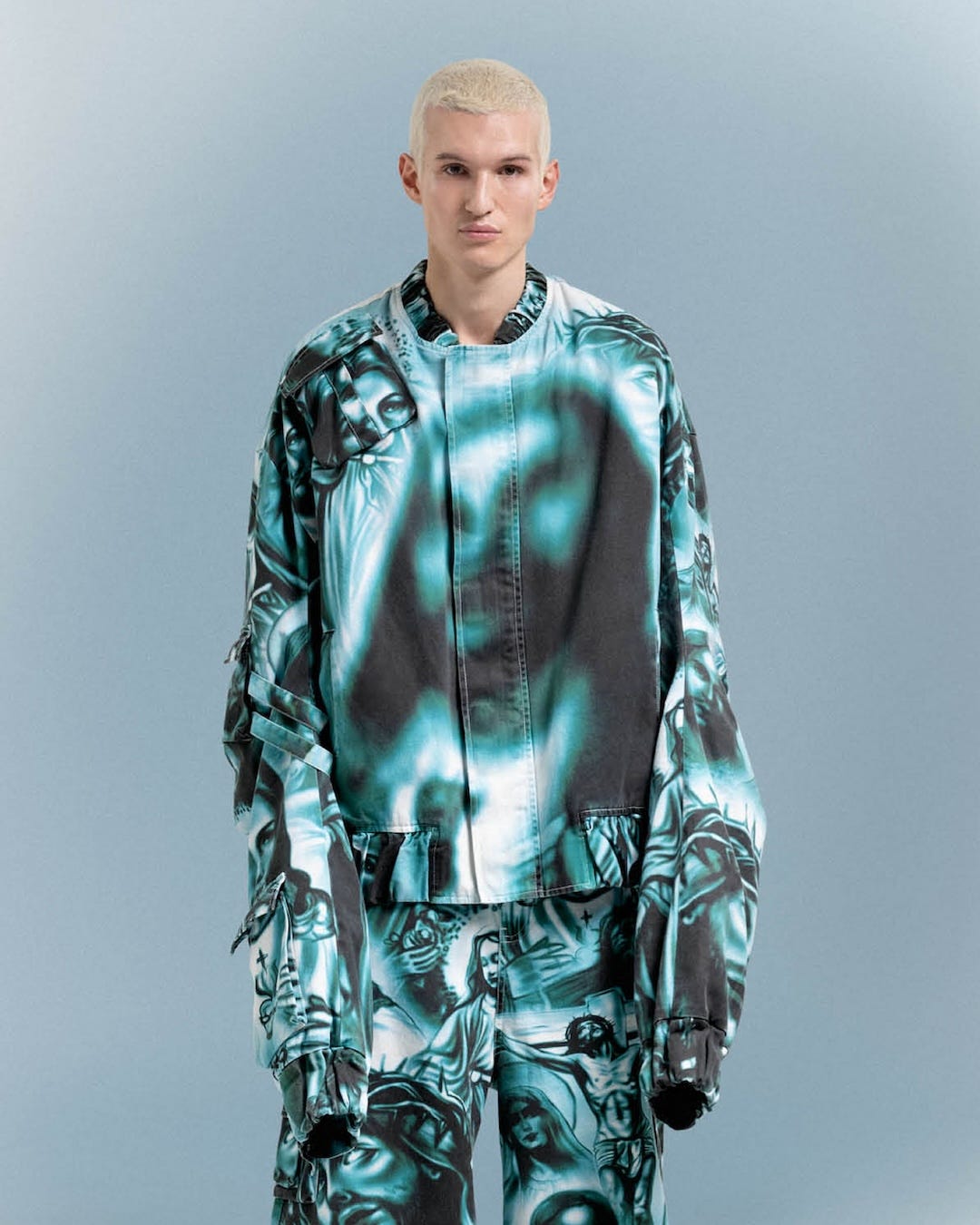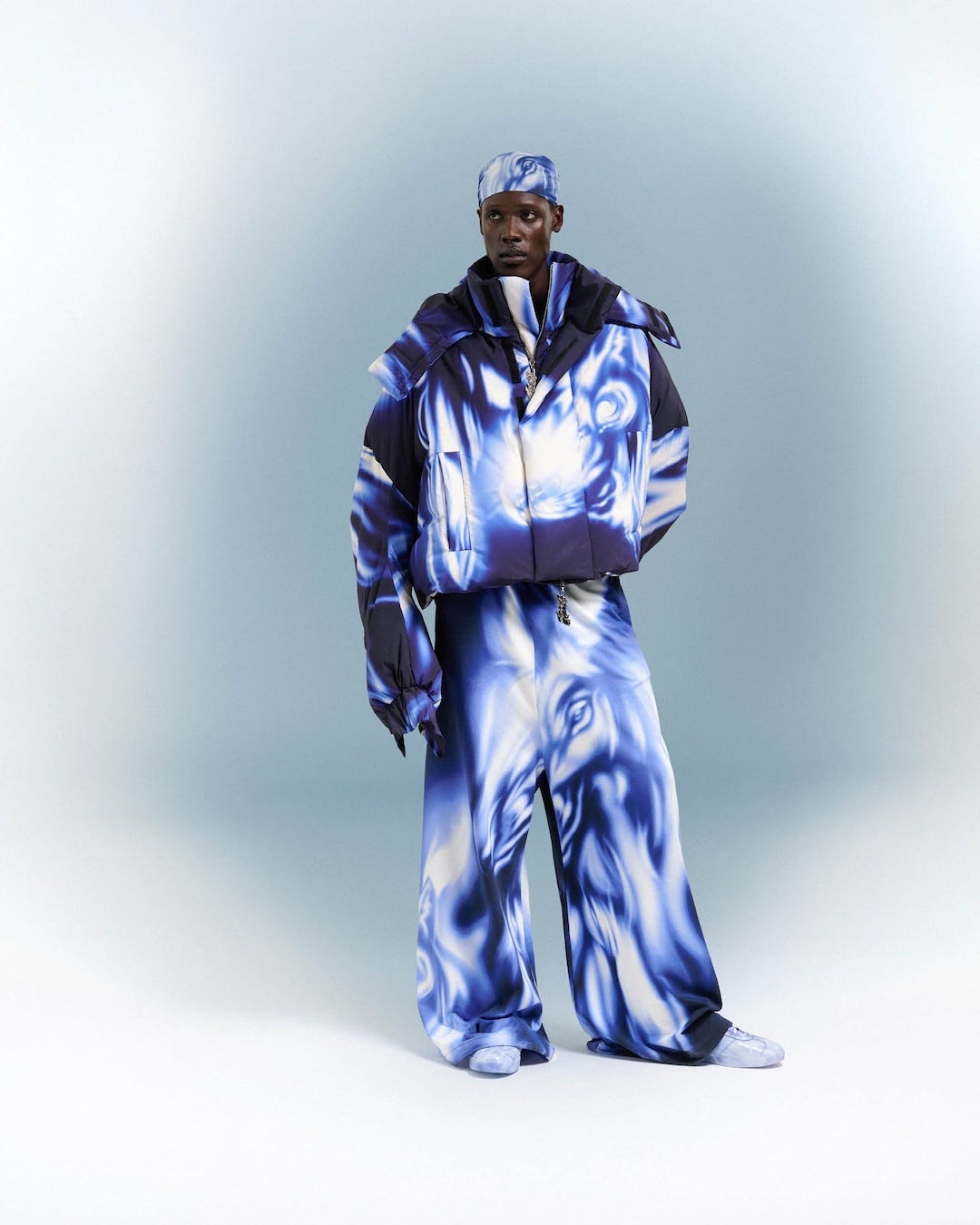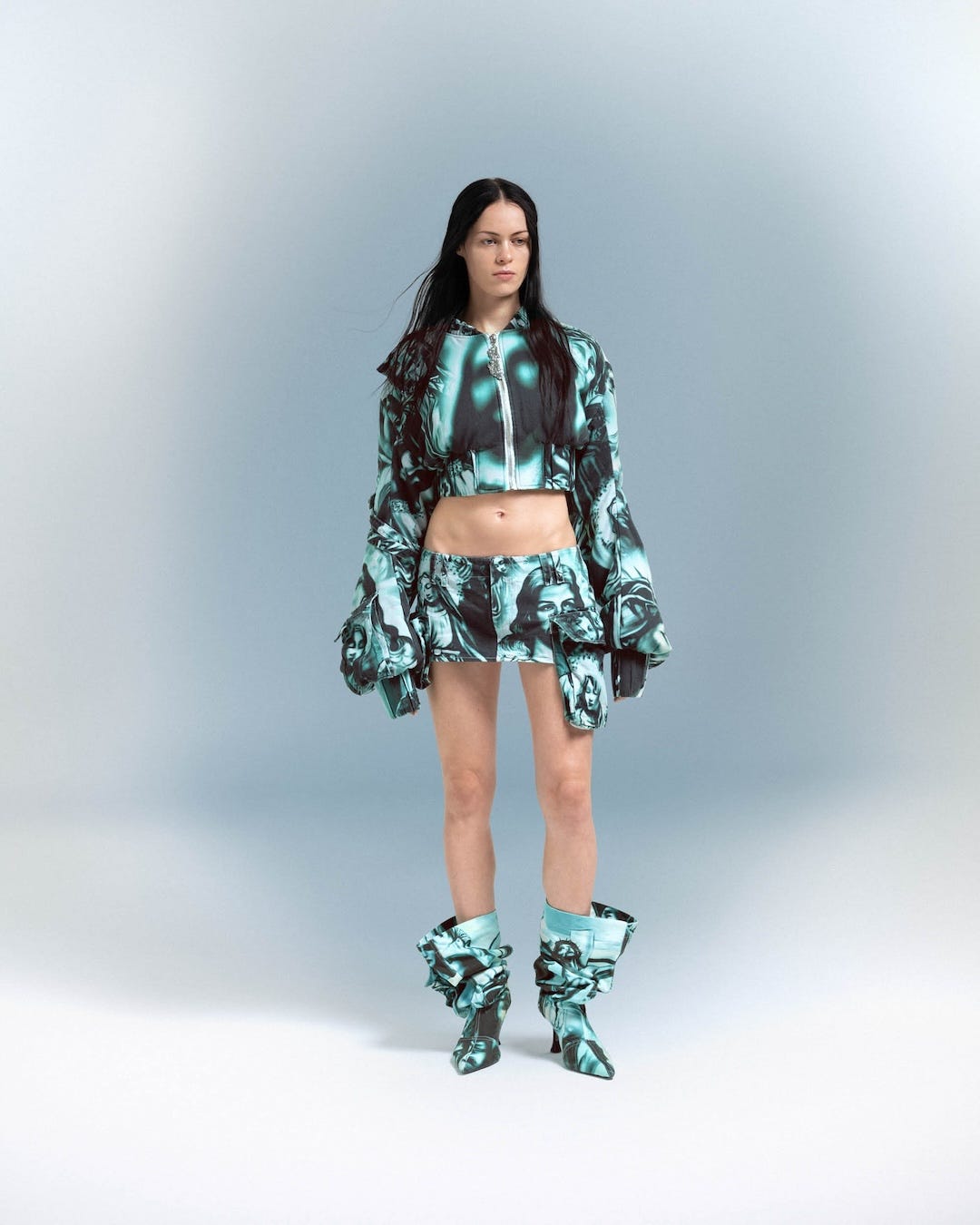GERRIT JACOBS HAS BIGGER PLANS
From broke student to developing one of music’s most coveted brands
A$AP ROCKY HAS donned quite a few memorable looks over the years. Crowd favorites include those of the Met Gala, his campaigns with Gucci and Bottega, and his popularized babushka look from the 2019 music video “Babushka Boi.” But when I think of moments encapsulating Rocky’s gravity as a dedicated father, a doting husband, and a disruptor of norms, I often ruminate on a scene from his “RIOT (Rowdy Pipe'n)” music video. In it, he wears an oversized custom two-piece made of white leather, airbrushed with the American flag on the front, and on the back, illustrations of his first-born son, RZA, and wife, Rihanna.
The look, designed by Berlin-based designer Gerrit Jacob, appears for a mere five seconds—an unexpectedly subtle moment given it’s one of the few custom pieces in the entire video. Being worn by Rocky in this context is both a blessing and a challenge. The designer doesn’t care about exclusivity for exclusivity’s sake. “I want to be worn by more people,” he tells me over a call, dismissing any notion of gatekeeping.
Still, I can’t shake the feeling that they’re unintentionally elusive because they’re meant to be. We’ve seen designers buckle under the weight of their greatness: Phoebe Philo’s departure from Céline in 2017. Or Raf Simons leaving Dior in 2015, where he publicly discussed his need for reflection: “You have no incubation time for ideas, and incubation time is very important. When you try an idea, you look at it and think, ‘Hmm, let’s put it away for a week and think about it later.’ But that’s never possible when you have only one team working on all the collections,” he said at the time. Even Peter Do left Helmut Lang earlier this Fall due to speculations about resources and workload. Perhaps Jacob, though not desired, is being saved by divine fate.
HIS CAREER TRAJECTORY is a study in contrasts: he’s as rebellious as he is meticulous, as idealistic as he is pragmatic. He grew up in Hamberg, a port city in northern Germany that, in his eyes, was not to be considered creative, let alone much of a “fashionable city.” He describes his father, a truck driver, and mother, a florist, as a “normal working-class family.” However, he also admits that financial instability was a big part of his childhood. It shaped his desire to leave, telling me that “At some point, I said, ‘Okay, I need to make sure that doesn’t happen to me.’”
This conviction for escapism is fundamental to his upbringing, a 90s baby living through Germany’s reunification process and experiencing its impact firsthand. The West’s abundant industrial economy absorbed the East’s less developed structure. This ignited bountiful opportunities for some, increasing trade to newly expanded ports along the country's northern edge. For others, including Jacob and his family, it was economic strife. Consumption demand drove up inflation, tax rates rose to an all-time high, and employment rates increased.
Much of Germany’s already limited creative fields had evaporated as work became more about stability. For Jacob, whose appetite for opportunities beyond the German border eclipsed his sense of homeland familiarity, staying wasn’t an option. “I knew I was going to have to leave at some point. It became very clear,” he recalls.
Diana: Her Life in Fashion was the first introduction he had to evade reality—A gift from his gay uncle, who perhaps sensed Jacob’s penchant for fashion. “She’s wearing this Versace dress on the cover,” he gleams, recounting the photos and illustrations that filled the pages. Coupled with a new computer, Jacob was on a path of discovery, often lingering on the works of Egon Schiele, Gustav Klimt, and Otto Dix. “All those sort of German, Austrian painters,” he notes.
By the time he was 16, it wasn’t enough to be on the periphery of this newfound world. He needed to be at its heart. For two years, Jacob worked, saving everything he could to eventually attend Central Saint Martins in London, a world-renowned design school known for its historic graduates. “Galliano, McQueen, Chalayan, Pugh…” Jacob begins listing the famous alumni. It was the only logical choice forward and a means of escape. “Obviously, I have to go to the one school everyone went to,” he grins.
The path forward wasn’t exactly clear, though. Besides knowing fashion’s greatest stars, Jacob’s understanding of the school was fragmented, discoverable only in small bits through hours of scouring the internet. “Facebook just started. You couldn’t look at people’s portfolios,” he gripes. “You couldn’t look at their career path.”
Despite this, he took a leap of faith, landing in the UK and securing a seat in those sacred halls. Then it hit—“I was 18, moving to a different country, different language, different culture.” Jacob was a German native on British soil, never mind that his peers were hesitant to befriend a foreigner who would disappear if he got axed. So, at least in the meantime, he kept his head down and worked. His first year was foundational, setting the grounds for whether or not he had the chops to make it long-term. “Everyone’s trying to get in. It’s really competitive,” he remarks.
Again, money became a prominent battle he couldn’t escape. Despite his diligence as a teen, remarking about the five thousand euros he saved working odd jobs, Jacob was quick to underestimate this new life. “I remember thinking, ‘I’m rich!’” he laughs. “I had so much money! Then I arrived, and it was gone within four months.”
It seemed capitalism was punching down at every angle. The timing was crucial with Britain, one of the largest economies and an influential member state within the EU, now pulling its support as part of Brexit. “Thankfully, I was able to borrow money from the government to cover my fees,” he sighs. Though Jacob dodged a bullet, he remains sympathetic to aspiring designers today—“The younger kids that just don’t have those same opportunities.”
AS A DESIGNER, his approach is far removed from the German tropes of austerity set before him. Where Jil Sander’s crisp minimalism and Karl Lagerfeld’s rigid structures dominated, Jacob opted for something more “messy,” as he puts it.
His master's collection, which he laughs at and says has been “scrubbed off the internet,” foreshadowed what was to come, featuring hand-painted imagery that informs his work today. The collection landed him a job at Gucci under Alessandro Michele, where he honed his maximalist approach, driving an even further wedge between the steely German aesthetic and his vision.
Gesturing to his desk, he flips the camera to reveal floods of colorful sketches, fabric, and finishings piled and spread into a sea of endless creation. “In terms of time, I’m very organized. In terms of space, I’m not,” he erupts into laughter.
I catch glimpses of his latest collection: airbrushed hues of blue and aqua depicting religious figures like Mother Mary holding baby Jesus or the messiah crowned with thorns. Similar to collections before, it feels fresh in a fashion world that can seem increasingly derivative. Even titans replicate work—Demna’s particular penchant to emulate the revered Martin Margiela comes to mind. But you’d be pressed to find anyone doing something similar to Jacob right now. In that case, his work defies all notions of irrelevance. Being original in today’s culture of unoriginality is a necessity.
“It’s not about being loud. It’s about being messy,” he insists, noting that the root of his aesthetic is simply allowing the mind to wonder. “I leave time to just create without a purpose.”
As someone who counts Rosalía, Lewis Hamilton, and Burna Boy among his clientele, you wouldn’t think Jacob was concerned about growth. After all, he’s amounted to more at 31 than most designers could dream of. But that couldn’t be further from the truth. Even with a rampant trajectory, he still worries, bluntly telling me, “If you’re not organized, the company will die.”
Every morning, like clockwork, he checks his bank account. “When is this getting paid? This is overdue. When is it coming?’” He rattles off the list with angst. Jacob has become meticulous about his finances but isn’t without cause. After all, witnessing his parents' financial struggles struck a chord with him.
Even now, weeks after our interview, I sense the fear listening back through the audio. Perhaps I’m projecting, or the fact that the fashion industry has hit some seriously troubled waters is overlaid in our conversation, but he speaks as if the rug would be ripped out from under him at any moment. “I’m still trying to pay rent on time every month,” he says. “It’s not like I’m selling 150 leather jackets every week.”
That pragmatism extends to his approach to celebrity endorsements. He understands the need to maintain buzz but is conscious of “not indulging in these things too much,” putting focus on organic growth. It’s about moving forward creatively, pushing his limits, and experimenting in his time. The last thing he wants is to become a “caricature” of his own design that caters to absorbent demands. “I think a lot of designers, especially those who have been working for a long time, become known for a certain thing, and it’s important that [my work] continues to feel honest,” he says.
As he continues to grow his brand, he’s steadfast in his refusal to be pigeonholed, and honesty seems to be Jacob’s North Star. It’s how he maintains authenticity, which he found critical in selling his clothes. “Americans and Japanese consumers are more likely to buy something they believe in,” he explains. Their belief in the product is an extension of his own, admitting that he’s done what buyers have asked of him, developing commercial merchandise, but “They never really perform that well.”
Note to self: follow your gut.
For Jacob, authenticity isn’t just a buzzword; it’s the currency that keeps his business and art alive. For this reason, I believe his steady growth is necessary. Though honest about wanting more exponential exposure and sales, he’s, without a doubt, exactly where he needs to be. Jacob has built a career on his own terms. For that, he doesn’t just deserve a seat at fashion’s table—he’s already carved out his own. ♣♠










